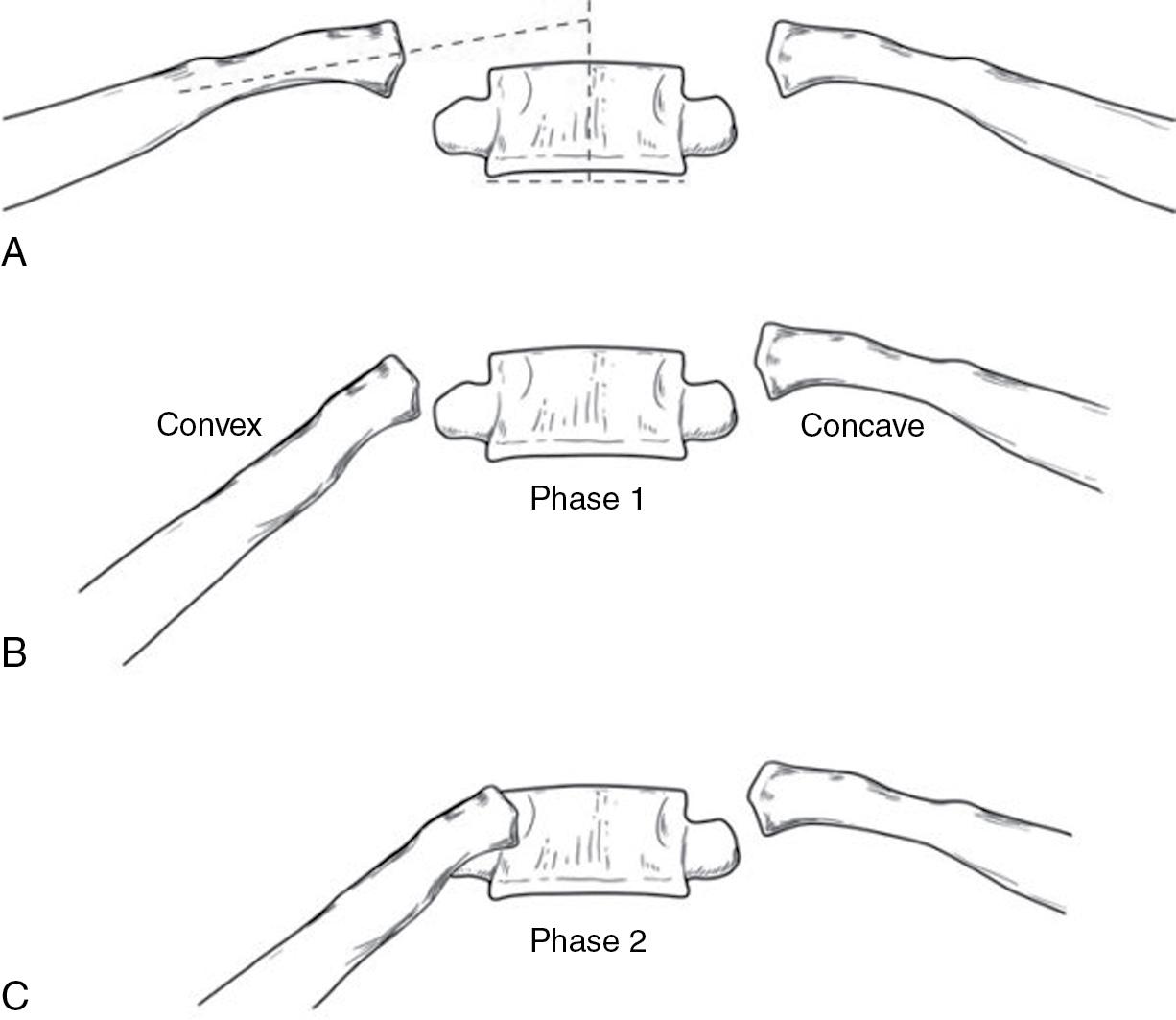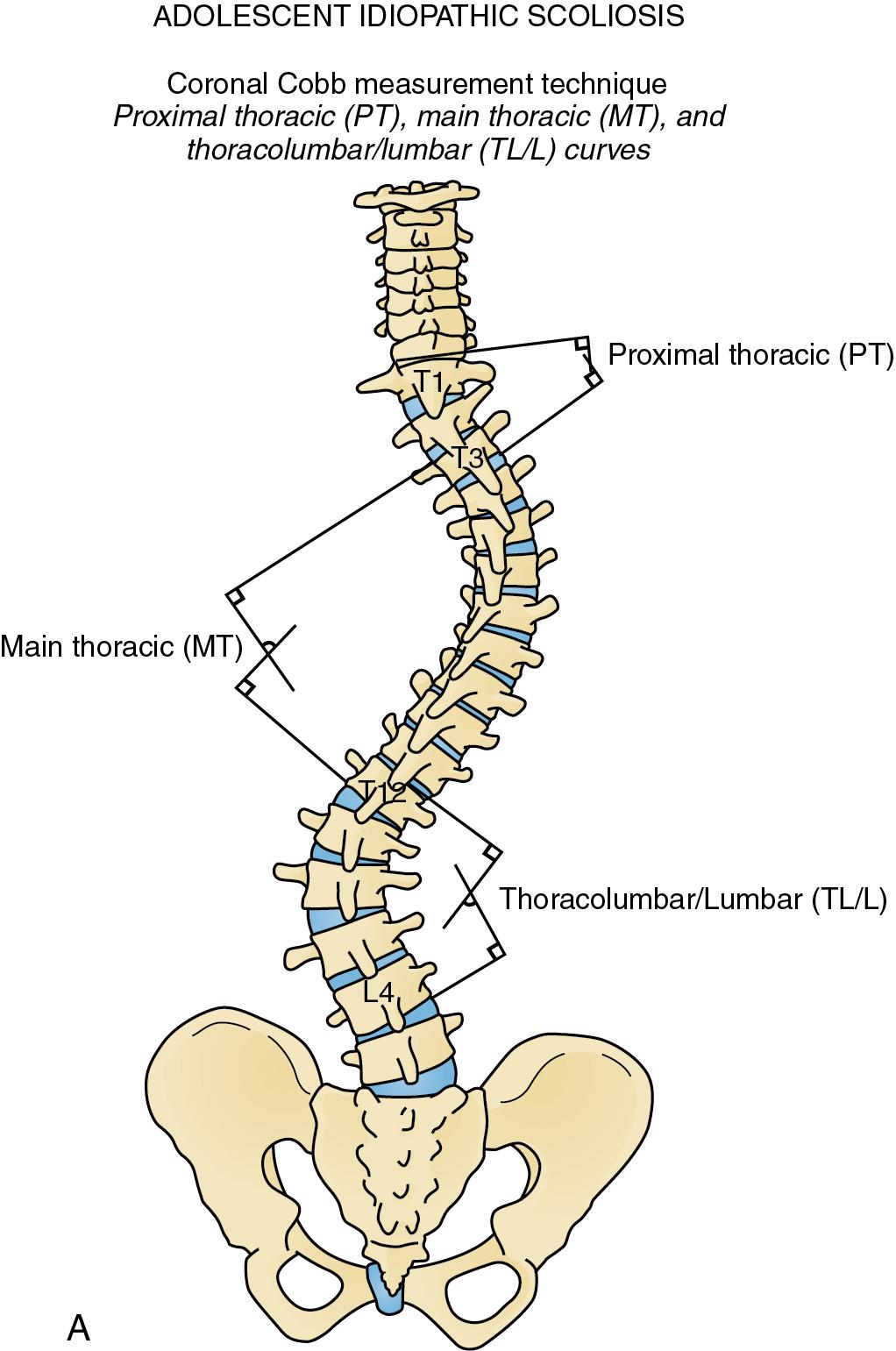Physical Address
304 North Cardinal St.
Dorchester Center, MA 02124
Idiopathic scoliosis is the most common type of scoliosis. At present it is uncertain whether this deformity represents a single disease entity or reflects a similar clinical expression of several different disease states. Idiopathic scoliosis is defined as a spinal deformity characterized by lateral bending and fixed rotation of the spine in the absence of a known cause. The criterion for diagnosis of scoliosis is a coronal plane spinal curvature of 10° or more as measured by the Cobb method. Curves less than 10° are referred to as spinal asymmetry . Traditionally, idiopathic scoliosis has been classified according to age at onset as infantile (birth–3 years), juvenile (4–10 years), and adolescent (>10 years) subtypes. Current terminology classifies idiopathic scoliosis that is present before 10 years of age as early-onset scoliosis (EOS) and idiopathic scoliosis that develops after 10 years of age as late-onset scoliosis .
The exact cause of idiopathic scoliosis has not been established and remains the focus of ongoing research. A significant challenge associated with this research is distinguishing whether observed changes are secondary to spinal deformity or whether they are the cause of the deformity. Areas under investigation include:
Genetic factors: Genome-wide association studies have identified single-nucleotide polymorphisms, or genetic variations, associated with adolescent idiopathic scoliosis.
Neuromuscular factors: Areas of investigation have included central nervous system asymmetry, vestibular and proprioceptive dysfunction, and impaired paravertebral muscle strength.
Hormonal and metabolic influences: Research has investigated relationships between melatonin, somatomedin, osteopenia, and idiopathic scoliosis.
Skeletal growth disturbances: Anterior spinal column overgrowth and differential growth between the right and left sides of the spinal column have been considered as potential etiologies.
Environmental and lifestyle influences: Diet and calcium and vitamin D intake have been the subject of investigations.
More common in Europe than in the United States (<1% of cases in United States)
Male predominance (vs. adolescent idiopathic scoliosis, which is more common in females)
Left thoracic curve pattern involving the mid to lower thoracic region is most common (vs. adolescent idiopathic scoliosis, in which right-sided thoracic curves are typical)
Association with plagiocephaly, developmental delay, congenital heart disease, developmental hip dysplasia, and neural axis abnormalities
Two types have been identified: a resolving type and a progressive type
Resolving and progressive curve types are distinguished by analyzing the relationship between the apical vertebra of the thoracic curve and the adjacent ribs on an anteroposterior (AP) radiograph in order to determine the rib-vertebral angle difference (RVAD) and rib phase .
The RVAD measures the amount of rotation at the apex vertebra and has prognostic value regarding curve progression in patients with idiopathic EOS. This angle is determined by a line perpendicular to the endplate of the apical vertebra and a line drawn through the center of the adjacent rib on both the concave and convex side of the apical vertebra ( Fig. 38.1 ). The RVAD equals the difference between the convex and concave angles. If the difference is greater than 20°, curve progression is likely.

The rib phase is determined by ascertaining whether the head of the convex rib overlaps the apical vertebral body and is used as an adjunctive measurement. If there is no overlap (phase 1), the RVAD is calculated to determine the likelihood of progression. If there is overlap (phase 2), the risk of progression is high.
Resolving curves are observed with serial physical examinations and radiographic monitoring. Sleeping in the prone position is recommended because supine positioning has been associated with infantile curves by some investigators. Progressive curves are treated with serial casting followed by orthotic treatment. Curves that continue to progress despite orthotic treatment require surgical treatment with posterior growth-friendly instrumentation techniques such as growing rods, the Shilla technique, or the vertical expandable prosthetic titanium rib (VEPTR). These posterior nonfusion instrumentation strategies attempt to control spinal deformity and delay the need for definitive fusion until the child has achieved additional growth. Posterior spinal fusion is not recommended due to adverse impact on the developing lungs and thoracic cage and lack of effectiveness in controlling spinal deformity in this population.
Juvenile idiopathic scoliosis represents a gradual transition from the characteristics of infantile idiopathic scoliosis to those of adolescent idiopathic scoliosis. ( ) Characteristic features include:
Less common than adolescent idiopathic scoliosis (12%–21% of all patients with pediatric idiopathic scoliosis)
Increasing female predominance is noted with increasing age (female-to-male ratio is 1:1 from 4 to 6 years and increases to 8–10:1 from 6 to 10 years)
Most common curve patterns are right thoracic and double major curve types
Approximately 70% of curves progress and require some form of treatment (bracing or surgery)
Magnetic resonance imaging (MRI) of the entire spine to visualize from the craniocervical junction to the sacrum is appropriate (also in infantile idiopathic scoliosis) because spinal deformity may be the only clue regarding the presence of a coexistent neural axis abnormality, which may potentially require treatment (e.g., syrinx, Arnold-Chiari malformation, tethered spinal cord)
Curves less than 20°–25° are observed. Treatment is initiated for curves in the 25°–50° range. Treatment most commonly consists of bracing, although a period of casting may be considered for younger patients or patients with rigid curves. Surgical treatment is considered when curve magnitude exceeds 50°–60°. Surgical decision-making is complex in this heterogeneous population. Growth-friendly treatment strategies such as posterior growing-rod techniques, the Shilla technique, or VEPTR are options that may be used to control deformity and delay spinal fusion to allow for additional growth. While these posterior nonfusion strategies are associated with advantages compared with early spinal fusion, their disadvantages include the need for multiple operations, device-related complications, wound infections, iatrogenic radiation exposure, and repetitive exposure to anesthesia. Another treatment option for curves less than 65° in older juvenile patients is anterior vertebral body tethering. This involves placement of screws into the vertebral bodies on the convexity of a curve through a thoracoscopic or thoracotomy approach. The screws are connected to a flexible polymer cord, which is tensioned to provide initial curve correction and allows for additional curve correction with continued growth. Patients with severe curves in excess of 80° are considered for treatment with a period of halo-gravity traction ranging from 2 to 6 weeks prior to definitive anterior and/or posterior procedures. Definitive surgical procedures most commonly consist of combined anterior and posterior fusion and attempts are made to defer such procedures until patients approach age 10. Isolated posterior fusions are at risk of the crankshaft phenomenon due to persistent anterior spinal growth in the presence of a posterior fusion, which may lead to recurrence of the spinal deformity.
Most common type of scoliosis in children and comprises approximately 80% of all pediatric patients with idiopathic scoliosis (prevalence is 3% in the general population)
Few adolescent patients (0.3%) develop curves requiring treatment
Female predominance, which increases substantially for larger curves requiring treatment
Thoracic curve patterns are generally convex to the right (atypical curve patterns are an indication for MRI)
Idiopathic scoliosis in adolescence is not typically associated with severe pain
Patient history
Inquire about when and how the deformity was recognized.
Inquire regarding history of pain, numbness, weakness, or bowel or bladder symptoms.
Discuss with family regarding patient’s maturity (include menstrual history in females), growth pattern, birth and developmental history, and family history of scoliosis.
Physical examination
Height and weight assessment.
Observation. Assess for shoulder, thorax, or waist asymmetry. Note any cutaneous lesions including café au lait spots, abnormal hair patches, or skin dimpling.
Adams forward bend test. The right and left sides of the trunk should be symmetrical. Presence of a thoracic or lumbar prominence suggests scoliosis. Use a scoliometer or digital assessment application on a smartphone to quantitate asymmetry by measuring the apical trunk rotation (ATR). Values ≥7º are considered abnormal.
Neurologic evaluation. Assess motor strength, deep tendon reflexes, abdominal reflexes (abnormalities may indicate intraspinal pathology such as syringomyelia), plantar reflexes, clonus testing, cranial nerve function, and balance.
Assess ligamentous laxity as a screen for connective tissue disorders.
Upper and lower extremity assessment. Evaluate gait and leg lengths.
Imaging assessment
A standing posteroanterior (PA) and lateral full length spinal radiographs or low-dose biplanar slot scan images are obtained.
Side-bending radiographs are not required for a routine initial patient evaluation and are reserved for presurgical planning.
Standard hand bone age films are obtained to assess skeletal maturity.
MRI is not required in the absence of abnormal physical examination findings, atypical radiographic findings, or a history of atypical pain.
Important radiographic parameters to assess in relation to scoliosis ( Fig. 38.2 A, B) include:
End vertebra: The upper and lower vertebrae that tilt maximally into the concavity of the curve are termed the end vertebrae. The cephalad end vertebra is the first vertebra in the cephalad direction from the curve apex whose superior endplate is tilted maximally toward the concavity of the curve. The caudad end vertebra is the first vertebra in the caudad direction from the curve apex whose inferior endplate is tilted maximally toward the concavity of the curve.
Apical vertebra: The apical vertebra is the central vertebra within a curve. It is typically the least tilted, most rotated, and most horizontally displaced vertebra from the central sacral vertical line.
Curve location: The curve location is defined by its apex which may be a vertebral body or an intervertebral disc.
| Curve | Apex |
| Cervicothoracic | C7 or T1 |
| Thoracic | Between T2 and T11–T12 disc |
| Thoracolumbar | T12 or L1 |
| Lumbar | Between L1–L2 disc and L4 |
| Lumbosacral | L5 or S1 |
Curve direction: Curve direction is determined by the side of the convexity. Curves convex toward the right are termed right curves, while curves convex to the left are termed left curves.
Curve magnitude: The Cobb technique is used to determine curve magnitude. Perpendicular lines are drawn in relation to reference lines along the superior endplate of the upper end vertebra and along the inferior endplate of the lower end vertebra. The angle created by the intersection of the two perpendicular lines is termed the Cobb angle and defines the magnitude of the curve.
Central sacral vertical line (CSVL): A vertical line on a coronal radiograph that passes through the center of the sacrum.
Neutral vertebra: A vertebra without axial rotation with reference to the most cephalad and caudad vertebra that are not rotated within a curve. Rotation is assessed based on the radiographic appearance of the vertebral pedicle shadow in reference to the lateral margins of the vertebral body (Nash-Moe classification). In a neutrally rotated vertebra the pedicle shadows will be equidistant from the lateral vertebral margins.
Stable vertebra: The vertebra bisected by the CSVL.

Become a Clinical Tree membership for Full access and enjoy Unlimited articles
If you are a member. Log in here